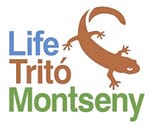Slider 3
Life Tritó Montseny
Un símbol de la natura del Montseny
Subbanner
LIFE15 NAT/ES/000757
Project of conservation of an only species to the world
Breadcrumb
Evolution
Evolution of the project Life Tritó Montseny
Asset Publisher


Biosafety
13/10/2020 15:32 h.
The Life Tritó Montseny publishes a manual of good practices in the field of biosafety
A new manual on biosafety for the discovery of amphibians has been drafted for environmental education entities, nature schools and educational centers. It aims to disseminate the problem of infectious diseases in amphibians and to raise awareness among the population so that they can carry out educational activities without introducing pathogens into the environment.
It is a tool published in digital format and also in paper, aimed at preventing the transmission of infectious diseases caused by fungi and viruses that seriously affect many species of this group of animals.
The document is the result of two working groups organized under the title "Emerging diseases in amphibians: guidelines and biosafety guidelines for educational activities in the aquatic environment of Montseny", in which participated environmental education, conservation and volunteer organizations, as well as educational centers.
According to data from this 2020 from the International Union for Conservation of Nature, 41% of known species of amphibians worldwide are threatened. One of the main factors that have motivated this situation is the infectious diseases caused by fungi, viruses and other pathogens, which can cause massive deaths of individuals.
The entry of pathogens that cause these deadly diseases is therefore a serious threat to wild populations of Montseny newt (Calotriton arnoldi). Aware of this fact, from the Life Tritó Montseny project, a good practices manual has been developed to disseminate the problem of these diseases and to raise awareness among the population so that they can carry out environmental education activities of discovery without introducing pathogens into the environment. This type of activities are considered a very valuable and attractive educational resource to approach nature, know it and, above all, respect it.
The document includes contents such as the measures to be adopted in the discovery of a stream or water point and the handling of amphibians; the protocol for the disinfection of materials for the collection of samples in the field; the sampling equipment necessary to take into account the disinfection of the material, and a section on prevention (malpractice due to ignorance, release of exotic species), among others.
The manual, whose recommendations can be useful both in the Montseny and in any other territory, closes with a decalogue that summarizes what can and cannot be done in relation to the study and handling of amphibians to avoid the transmission of infectious diseases.
The graphic design, very didactic and attractive, has been in charge of Lucas Wainer; the technical content, by Daniel Fernández and Albert Montori, and the coordination, by the Natural Park and Biosphere Reserve of Montseny.
The 5,000 printed copies will be distributed among the partners of the Life Tritó Montseny project (Barcelona Provincial Council, which coordinates it; Girona Provincial Council; the Government of Catalonia, through the Department of Territory and Sustainability and the Catalan Forestry Department, and the Barcelona Zoo), the educational centers of the Natural Park, the environmental education facilities of the territory and the entities participating in the work group.
Parallel to the manual, there is a protocol called "Biosafety: sanitary protocols for activities involving direct or indirect interaction with amphibian populations in the natural environment" which is basically aimed at construction contractors and scientific entities that carry out activities in aquatic environments.
It has been prepared by Daniel Fernández, Albert Montori, Laia Pérez Sorribes and Salvador Carranza, with the collaboration of the staff of the Montnegre Park and Corridor and the Montseny Natural Park and Biosphere Reserve. This is a technical document basically aimed at people who carry out scientific activities in the natural environment.


